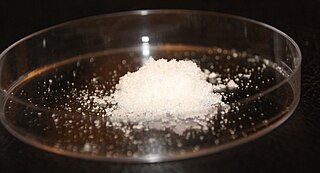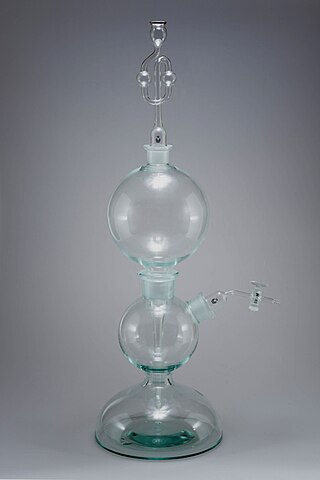Related Research Articles
Marquis reagent is used as a simple spot-test to presumptively identify alkaloids as well as other compounds. It is composed of a mixture of formaldehyde and concentrated sulfuric acid, which is dripped onto the substance being tested. The United States Department of Justice method for producing the reagent is the addition of 100 mL of concentrated (95–98%) sulfuric acid to 5 mL of 40% formaldehyde. Different compounds produce different color reactions. Methanol may be added to slow down the reaction process to allow better observation of the colour change.
Classical qualitative inorganic analysis is a method of analytical chemistry which seeks to find the elemental composition of inorganic compounds. It is mainly focused on detecting ions in an aqueous solution, therefore materials in other forms may need to be brought to this state before using standard methods. The solution is then treated with various reagents to test for reactions characteristic of certain ions, which may cause color change, precipitation and other visible changes.

Sulfamic acid, also known as amidosulfonic acid, amidosulfuric acid, aminosulfonic acid, sulphamic acid and sulfamidic acid, is a molecular compound with the formula H3NSO3. This colourless, water-soluble compound finds many applications. Sulfamic acid melts at 205 °C before decomposing at higher temperatures to water, sulfur trioxide, sulfur dioxide and nitrogen.

Kipp's apparatus, also called a Kipp generator, is an apparatus designed for preparation of small volumes of gases. It was invented around 1844 by the Dutch pharmacist Petrus Jacobus Kipp and widely used in chemical laboratories and for demonstrations in schools into the second half of the 20th century.

Ammonium metavanadate is the inorganic compound with the formula NH4VO3. It is a white salt, although samples are often yellow owing to impurities of V2O5. It is an important intermediate in the purification of vanadium.
A nitrate test is a chemical test used to determine the presence of nitrate ion in solution. Testing for the presence of nitrate via wet chemistry is generally difficult compared with testing for other anions, as almost all nitrates are soluble in water. In contrast, many common ions give insoluble salts, e.g. halides precipitate with silver, and sulfate precipitate with barium.

Folin's reagent or sodium 1,2-naphthoquinone-4-sulfonate is a chemical reagent used as a derivatizing agent to measure levels of amines and amino acids. The reagent reacts with them in alkaline solution to produce a fluorescent material that can be easily detected.
Keller's reagent can refer to either of two different mixtures of acids.
Ehrlich's reagent or Ehrlich reagent is a reagent containing p-dimethylaminobenzaldehyde (DMAB) and thus can act as an indicator to presumptively identify indoles and urobilinogen. Several Ehrlich tests use the reagent in a medical test; some are drug tests and others contribute to diagnosis of various diseases or adverse drug reactions. It is named after Nobel Prize winner Paul Ehrlich who used it to distinguish typhoid from simple diarrhoea.
The Liebermann reagent named after Hungarian chemist Leo Liebermann (1852-1926) is used as a simple spot-test to presumptively identify alkaloids as well as other compounds. It is composed of a mixture of potassium nitrite and concentrated sulfuric acid. 1 g of potassium nitrite is used for every 10 mL of sulfuric acid. Potassium nitrite may also be substituted by sodium nitrite. It is used to test for cocaine, morphine, PMA and PMMA.
The Mecke reagent is used as a simple spot-test to presumptively identify alkaloids as well as other compounds. It is composed of a mixture of selenous acid and concentrated sulfuric acid, which is dripped onto the substance being tested.
Simon's reagent is used as a simple spot-test to presumptively identify alkaloids as well as other compounds. It reacts with secondary amines like MDMA and methamphetamine to give a blue solution.
The Froehde reagent is used as a simple spot-test to presumptively identify alkaloids, especially opioids, as well as other compounds. It is composed of a mixture of molybdic acid or a molybdate salt dissolved in hot, concentrated sulfuric acid, which is then dripped onto the substance being tested.
The murexide test is an analytical technique to identify the presence of caffeine and other purine derivatives in a sample. These compounds do not respond to the common alkaloid identification tests such as Dragendorff's reagent. In this test, crude drugs are mixed with a tiny amount of potassium chlorate and a drop of hydrochloric acid. The sample is then evaporated to dryness and the resulting residue is exposed to ammonia vapour. Purine alkaloids produce a pinkish-purple color in this test due to formation of murexide, which the test is named after.

Dragendorff's reagent is a color reagent to detect alkaloids in a test sample or as a stain for chromatography plates. Alkaloids, if present in the solution of sample, will react with Dragendorff's reagent and produce an orange or orange-red precipitate. This reagent was invented by the German pharmacologist, Johann Georg Dragendorff (1836–1898) at the University of Dorpat.
The Gallic acid reagent is used as a simple spot-test to presumptively identify drug precursor chemicals. It is composed of a mixture of gallic acid and concentrated sulfuric acid.
The Zimmermann reagent is used as a simple spot-test used in chromatography to presumptively identify alkaloids, especially benzodiazepines, as well as other compounds. It is therefore used in drugs testing.

The Chen-Kao reaction is a chemical method for determining the presence of pseudoephedrine, ephedrine, and similar phenylalkylamines. The reaction is used in spot tests and is also known as Chen-Kao test. The test is often used to distinguish ephedrine, pseudoephedrine, norephedrine, cathinone and methcathinone from amphetamine and methamphetamine, which do not react with Chen’s test reagent.
Salkowski's test, also known simply as Salkowski test, is a qualitative chemical test, that is used in chemistry and biochemistry for detecting a presence of cholesterol and other sterols. This biochemical method got its name after German biochemist Ernst Leopold Salkowski, who is known for development of multiple new chemical tests, that are used for detection of different kinds of molecules. A solution that has tested positive on the Salkowski's test becomes red and gets yellow glow.
References
- 1 2 3 4 "Mandelin EZ Testing Kit". EZ Test. Retrieved 2012-01-27.
- ↑ "Reagent Tests UK - Mandelin reagent". Reagent Tests UK. Retrieved 3 April 2016.
- ↑ Poe, Charles F.; O'Day, David W. (2006). "A study of Mandelin's test for strychnine". Journal of the American Pharmaceutical Association. 19 (12): 1292. doi:10.1002/jps.3080191206.
- 1 2 "Color Test Reagents/Kits for Preliminary Identification of Drugs of Abuse" (PDF). Law Enforcement and Corrections Standards and Testing Program. July 2000. Retrieved 2011-07-24.
- ↑ "2-C-T-7 Mandelin". Reagent Base.
- 1 2 "Dancesafe Mandelin Reagent". Dancesafe. Retrieved 10 August 2015.
- ↑ Mahmood, Zafar Alam (2013). "Bioactive Alkaloids from Fungi: Psilocybin". Natural Products: Phytochemistry, Botany and Metabolism of Alkaloids, Phenolics and Terpenes. Springer-Verlag. pp. 523–552. ISBN 978-3-642-22143-9.